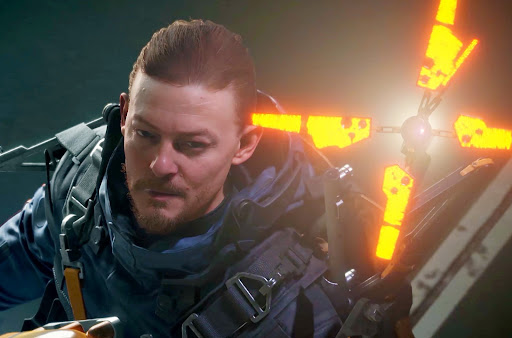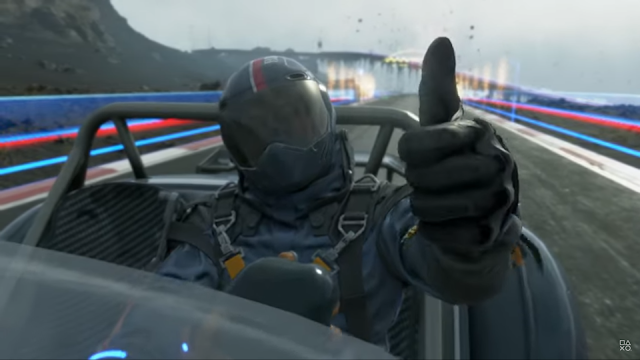I find the framing of the PlayStation 5 extended edition of Death Stranding intolerable. The concept of a “Director’s Cut” comes from cinema, and it represents the uncompressed creative vision of the director. Oftentimes a film has studio and producer meddling that results in a cinematic release that doesn’t align with the director’s full vision. A director doesn’t typically get final cut rights because studios know there’s an awful lot of directors that would alienate half the audience for creative reasons. There is absolutely no way any of this applies to Hideo Kojima, or his original Death Stranding. If anything, the stuff that’s been added for this “Director’s Cut,” which is all content with little substance and does little to nothing to add to the original vision, is the version that itself needs a director’s cut.
I mean, get a whiff of this stuff: There’s a high scores mode for proving you’re the best at the shootybang side of the game. That was always the least important part of Death Stranding and always felt like it was in there as a minimum-effort concession to the commercial reality of making a blockbuster game. Likewise goes the ability to re-fight bosses for high scores. There is a freaking race track. There are tools that make it easier to transport stuff around. See the problem with any of this? I’ll spell it out: it has taken a narrative-driven experience, that was not about shootybangs, vroom vrooms, or min-maxing, and “added” to all the stuff the game is not really about. In doing so, there’s a tonal inconsistency that’s in Death Stranding that now comes so very, very close to undermining the beautiful melancholia of the original game. Kojima himself doesn’t like calling this thing a “Director’s Cut”, and I very much wonder how involved he was in the extra content that has given Sony a “new” version to sell. It all this stuff really was Kojima himself adding to his creative vision, then sorry, buddy, but it didn’t click with me, because I replayed the game, almost step by step, exactly as I played it last time and ignored this new stuff as much as possible…
However, with the above being said, replaying Death Stranding in 2021 is a fascinating experience, and I highly recommend it for people that did play it on its original launch and not since. Real-world events over the past two years have given this game such a different context that it exists in an entirely different space now. The first time I played Death Stranding, COVID-19 wasn’t a thing yet. We were all naïve and happily so then, playing this quirky and unique apocalyptic game about people hiding away and only able to survive thanks to a special class of people – couriers – who risk everything to move supplies around.
This game raised so many questions through that concept, right down to questioning the very ideal of “America.” As I wrote in my review at the time: “On the most simple level, the game can be read as a broad critique on the steadily shallowing nature of relationships in our increasingly hyper-connected world. Kojima’s clearly looked at the Internet and the superficial relationships that it fosters, and decided that the society-wide isolation that it is driving us towards is not good for us. Sam rarely meets or talks with people face-to-face. The cities that he visits are empty, soulless places – the implication being that its people stay indoors at all times. He makes his deliveries to warehouses, where he talks to the holographic projection of the people that he’s interacting with. He does this to earn “likes” – what passes for experience points in Death Stranding’s universe, and is explicitly modelled after the validation we all go chasing from our own activities on social media. Those rare moments that he does have the opportunity to physically interact with someone, we discover that Sam has a phobia of being touched.
“More complex is Kojima’s commentary on broader American culture. This is more difficult to write about, because much of this commentary is locked behind the final few hours, and there’s just no way to unpack it without going heavy on the spoilers. Through much of the game the work that Sam does is under the auspices that it will “reconnect America” and recapture a very patriotic vision of what America is and means. For so (so) many hours the game plays this straight-faced and flat-toned and I – foolish me – did accept that the rhetoric was genuine. It’s not. It gets upended in the most shocking way imaginable as the revelations start coming in towards the end game, and as a social critique, Death Stranding hits on some truths and ideas that, you can only hope, will generate conversations about the American identity, culture, and how it both sees itself and its role in the world.”
The thing is, though – everything tht I wrote there from 2019. Before the pandemic. Before the US election and subsequent coup attempt. Before the relatively benign and spiritied social environment of the Internet was turned towards spreading misinformance, and encouraging anti-vaccination and weaponising conspiracy theories for clout became fair game. Before all what has happened since the release of Death Stranding – indeed all of which started happening almost immediately after the game was released – laid bare the gaping, deep disfunctions in America.
Playing Death Stranding now – now that we know just how prescient it somehow was – is a deeply eerie experience. The game goes from being the melancholic and understated lonely wandering game, set against a soundtrack of some of the most melancholic music, that it was in 2019, to being like having salt rubbed on a wound. Only, it’s not being done for the sadism of causing pain, but rather in a perhaps futile bid to stop the bleeding out. It now comes across as an effort to make us realise that there’s an impending crisis (beyond what we’e already experienced) and we do need to do some soul searching if we want answers and solutions. The very best works of art inspire these sometimes difficult conversations, and Death Stranding really does work hard to encourage us to think about what it’s saying.
Otherwise, the game remains the unique bit of genius that it was back on release. Whether it’s the surrealism of the babies in the bottle, the dark majesty of the beach that represents death in the world, the very Kojima names of “Sam Porter Bridges” (Sam’s a porter that takes things over bridges) amd “Die-Hardman,” or the little moments of fourth wall-breaking narrative or actions that gently remind you of the subversion in this work, Death Stranding is still an excellent experience. Furthermore, the second time around, I didn’t need to deal with the first couple of hours feeling so clumsy at the movement system. This time around I could enjoy the game right out of the box. Enjoy it I did, since I so rarely play (much less enjoy) blockbusters these days. The other eye-opening thing about replaying Death Stranding in 2021 is that it acts to remind you just how saccharine the rest of the “AAA” industry has become.
Matt S.
Editor-in-Chief
Find me on Twitter: @mattsainsb










